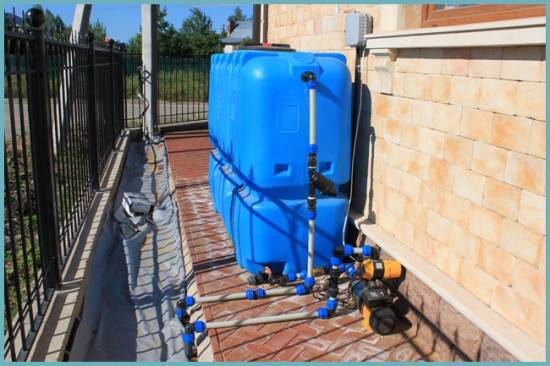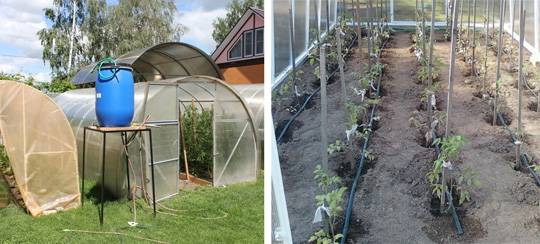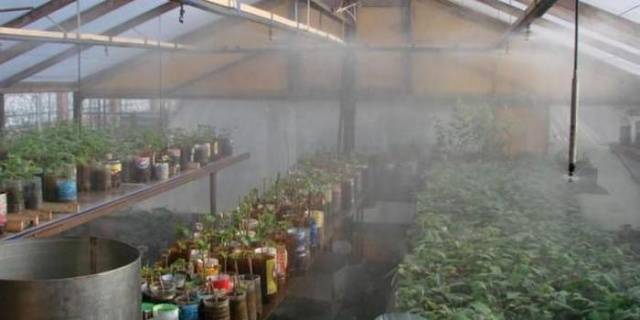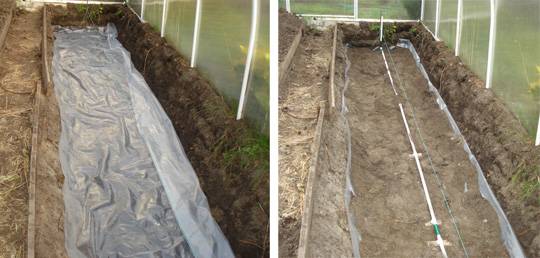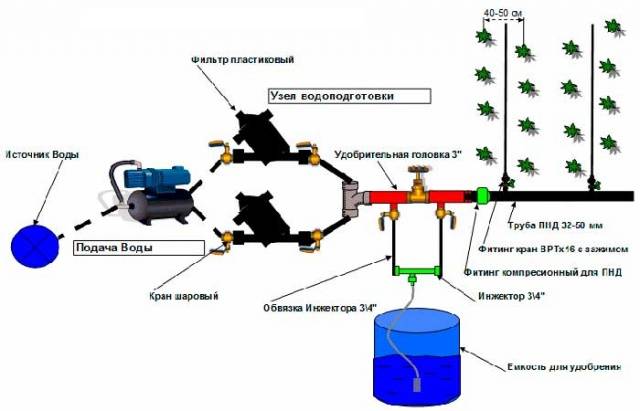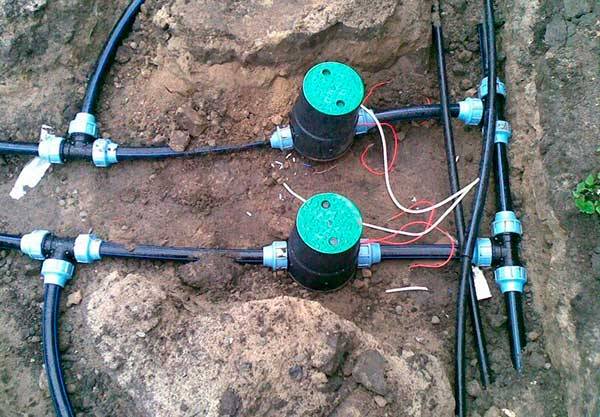Content
It will not be possible to grow a good harvest in a summer cottage without arranging irrigation. Not every summer is rainy, and if there is a greenhouse, artificial irrigation is indispensable. However, it is very difficult to perform this procedure manually every day. The way out of the situation is the automatic watering system, which is quite simple to make with your own hands.
The relevance of autowatering a summer cottage and a greenhouse
To grow different crops in a vegetable garden, in a garden or a greenhouse, it is necessary to organize an artificial irrigation system. The quantity and quality of the future harvest depends on the correctly chosen technology. There are 3 types of autowatering available for making in the country with your own hands: subsurface, drip and sprinkler irrigation. Each of the options presented is suitable for irrigation of open ground and greenhouse soil.
Automatic irrigation makes the daily laborious process of caring for crops easier for the person himself. The system will automatically deliver the required amount of water, evenly distributing it under the root of each plant. The most intelligent is the automatic irrigation system with a programmable timer. This device, working in conjunction with sensors, is responsible for supplying a certain amount of water at a given time. Thanks to this work, the possibility of waterlogging of the soil is excluded. For any of the selected automatic irrigation systems, you will need a pump, a tank, a source of water intake and, of course, pipes, taps and filters.
The entire irrigation system can be bought ready-made in the store, and at home it will only be necessary to assemble it. However, as practice shows, cheap automatic irrigation systems quickly fail, and expensive ones are not affordable for everyone. Many summer residents prefer to make their own autowatering for the greenhouse or vegetable garden using purchased components. So, they say cheaper and more reliable.
Three types of self-watering with your own hands
To make automatic watering of a greenhouse or a summer cottage is within the power of every owner. Probably the most difficult thing here will be connecting the electrical circuit, consisting of sensors and a controller. Usually, the automatics sold in the kit come with a diagram for its installation. In extreme cases, you can turn to a qualified electrician for help, but the autowatering pipe system itself can be assembled with your own hands.
Drip irrigation system
When making automatic watering in a greenhouse, it is best to give preference to a drip system. It is also the best option for open beds with cucumbers, tomatoes, peppers, cabbage. In a drip irrigation system, a certain amount of water is delivered directly to the root of the plant. This method eliminates sunburn of the leaves, as the water droplets act like a magnifying glass. It will grow less on the site weedsplus water savings.
The drip irrigation system is capable of operating from a central water supply, but in this case, cold water will get under the root of the plant.
Many thermophilic crops slow down their growth from this. The best option is a barrel or any plastic container. The water in the sun will heat up in it and be supplied warm to the roots of the plant.As it decreases, the water will be pumped into the barrel by the pumping station from the well or, under pressure, the liquid will come from the central water supply. A sanitary float with a built-in valve installed inside the barrel will help automate the process of pumping water.
The process of making drip irrigation system consists of the following steps:
- If the greenhouse is heated, and the plants are grown in it even in winter, then the barrel must be installed inside, otherwise the water will freeze on the street from frost. For cold film greenhouses with spring crops or open beds, an outdoor container installation is suitable. In any case, the auto-irrigation barrel must rise at least 1 m above the ground level to create a gravity flow of water.
- A hole is cut at the lowest point of the water tank, where the ball valve, filter and solenoid valve are sequentially attached. The latter is needed to automate the autowatering process, and the filter will purify the water from impurities so that the droppers do not get clogged.
- A plastic pipe of the main branch of the irrigation system is connected to the solenoid valve using an adapter. The diameter of the pipe depends on the area to be watered, but usually 32–40 mm is sufficient. The main branch of autowatering is laid between all the beds perpendicular to the rows with growing plants. The end of the pipeline is closed with a plug.
- Opposite each row, the pipe is cut with a hacksaw for metal, and then again it is connected with special fittings - tees. PVC pipes of a smaller section are connected to the central hole of each tee, but holes are drilled in them in front of each plant. If you wish, you can buy a perforated hose for automatic irrigation, however, its service life is slightly shorter.
- To prevent water from flowing from the drilled holes without stopping, you will have to buy droppers. They are screwed into each hole and placed not down to the soil, but to the side or up to avoid clogging. Do not insert the drip chamber into the factory perforated hose. Inside it, a special capillary labyrinth is already provided.
The autowatering system is ready to work. It remains to install soil moisture sensors and, together with the solenoid valve, connect to the controller.
The video tells about making do-it-yourself drip irrigation in a greenhouse:
Making rain autowatering
Sprinkler irrigation is most often used in the garden for watering lawns or in large vegetable gardens. Sometimes such an irrigation system is justified in a greenhouse when growing crops that love a humid microclimate, for example, cucumbers. When sprinkling, the water scattered by the sprinklers falls not only under the root of the plant, but also on its aboveground part. Sprinkler irrigation system can be independently made by over-soil or air method.
If the automatic irrigation system will operate from a barrel, as provided for in drip irrigation, it will be necessary to install a pump after the ball valve emerging from the tank at the bottom. The controller will also control its work.
Over-soil autowatering
The process of making an above-ground sprinkler system is similar to drip irrigation, only the entire plastic pipeline must be buried in the ground. Sprinklers are attached to the branches instead of droppers. These are special nozzles designed to spray water. In the final, the whole automatic irrigation system, buried in the ground, should turn out. Only the spray head is on the soil surface.
Making an air sprinkler system in a greenhouse
The air irrigation system allows you to create a rain effect inside the greenhouse. It is made similarly to the above-soil or drip system, only all pipes are on the surface.The main auto-irrigation line is laid under the greenhouse ceiling. Small descents of thin PVC tubes are made from it with sprayers installed at the end. The length of the descent depends on the height of the ceiling and the ease of maintenance at the discretion of the owner.
If a sprinkler system is installed in a garden, air humidity sensors will prevent the system from being unnecessarily turned on when it rains.
Making subsoil autowatering
Subsoil watering involves supplying water directly to the root of the plant. If, with surface drip irrigation, a wet spot forms around the plant, then with the intrasoil method, the entire garden bed is dry from above. This big plus eliminates the formation of a crust on the soil, which must be constantly loosened.
Subsoil autowatering is made in the same way as the drip system. The only difference is the lateral branches. They are made from a porous hose buried in the ground. At cost, the subsoil autowatering system is cheaper, but its disadvantage is the frequent clogging of the holes in the porous hose.
Drawing up a scheme and procedure for arranging autowatering in the country
Before proceeding with the manufacture of automatic irrigation, it is necessary to draw up an accurate diagram of all the nodes of the system, and the passage of the pipeline through the site. When using several central branches, it is advisable to make such a distribution so that the water source is located in the middle. This will help to create approximately the same pressure in all branches of the pipeline. One of the options for automatic irrigation schemes can be seen in the photo.
Digging a trench for pipe laying
The underground method of laying the automatic irrigation pipeline on the open ground is convenient because there is no need to disassemble the entire system for the winter, plus a lying pipe under the ground will not interfere with weeding in the garden bed. The trench depth is sufficient 400–600 mm. When backfilling, the plastic pipe is first sprinkled with sand or soft soil so that stones do not fall.
System installation
PVC pipes are connected with special fittings. This is a kind of clamping device made in the form of tees, turns and other elements. The pipe is cut into pieces according to the scheme, after which the connections are made. Depending on the selected autowatering system, sprayers or droppers are attached to the branches.
The last connection is made by the central branch of the pipeline to the pump. Backfilling of the trench is performed only after a successful test of the autowatering system for performance.
Important! Each pump is designed for a certain volume of pumping water. This indicator should be several units more than the total flow from all nozzles or droppers, otherwise there will be a weak pressure at the end points of the autowatering system.
Now is the time to connect the pump to the tank. Using adapters, the input of the unit is connected to a chain of a ball valve and an electromagnetic valve already assembled on a barrel. Water supply to the container is provided in a more convenient way. It can be a water supply system, a well, you can even pump it in from a nearby reservoir. To adjust the water level, a float with a valve is mounted inside the tank.
In the end, it remains to assemble the entire electrical circuit from sensors, a controller, a pump and an electromagnetic valve.
The video tells about the installation of automatic irrigation in the country:
As you can see, autowatering in the country can be done by hand without any problems. Of course, a little work will have to be done, but the convenience of its use will be noticeable.
Reviews of summer residents about autowatering
I gained my first experience in making sprinkler irrigation while working. Last year I made automatic watering in my garden and on flower beds near my house. With the beginning of spring, I plan to extend drip irrigation to the beds in the garden. Troubled business, but worth it.

